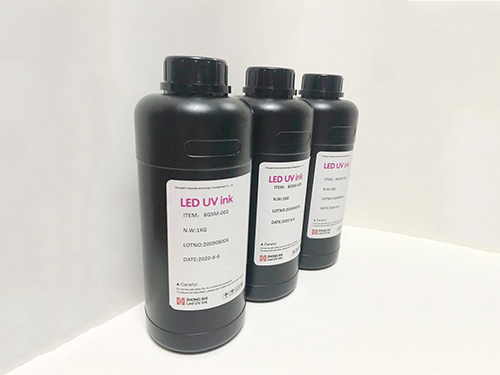Normally, the diameter of pigment particles in UV ink is less than 1 micrometer, it does not contain volatile organic solvents, has ultra-low viscosity, and no irritating odor, which can ensure that the ink does not block the nozzle during the spray printing process. After six months of high-temperature storage testing, there are no abnormal phenomena such as pigment condensation, sinking, and layering.
UV ink can be sprayed and dried immediately, and can be matched with various models of UV flat plate inkjet printers currently used in the market. UV ink is suitable for printing materials such as metal, glass, ceramics, PC, PVC, ABS, etc. The cured ink layer has high hardness, good adhesion, abrasion resistance, solvent resistance, and high gloss. UV ink currently available in C, M, Y, K, LC, LM, white, transparent, 8 colors, with a light resistance level of 7-8. Packaging 1 liter/barrel.
UV ink and weak solvent ink, due to their inherent characteristics, determine their respective application methods and fields. UV ink can be used together with white ink, so many manufacturers can print some beautiful relief effects. This is achieved by first stacking white ink to create a relief effect, and then printing with colored UV ink once to achieve the relief effect. However, weak solvents cannot be mixed with white ink, so they cannot print a relief effect.

In addition, due to the fact that many materials of weakly soluble ink require coating treatment during printing, printed products without coating treatment are prone to color fading; UV ink can be directly used to print many materials without any coating treatment, which is simple, convenient, and practical.
In terms of structure, the biggest difference between UV ink and traditional solvent ink is that it only contains very little or almost no volatile solvents (VOCs).
Traditional solvent based inks contain at least 50% or more of volatile solvents, which is the fundamental reason why UV inks are environmentally friendly.
Secondly, UV ink is generally composed of 30-40% main resin, 20-30% active monomers, as well as a small amount of photoinitiators and additives such as leveling agents and defoamers. Both the main resin and the active monomer have reactive activity.
Ordinary solvents, on the other hand, rely on the resin and pigments that evaporate from the solvent to form adhesion on the substrate, which determines its drying method. The performance of ink after drying varies. Generally speaking, UV ink has higher weather and solvent resistance properties; However, due to the formation of a cross-linked ink layer, overall, it is not as flexible as solvent ink.